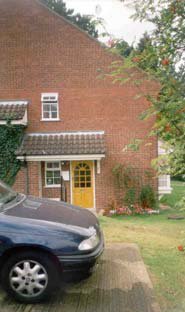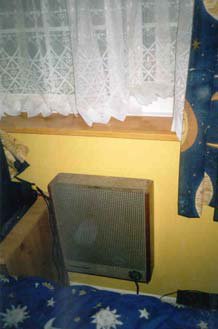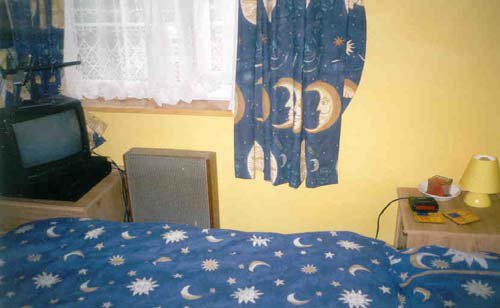


c
b
A)
A
Seriously defective
Defective
Not satisfactory
Satisfactory/NA
HHSRS VERSION 2
SEPTEMBER 2004
FIRE
Vulnerable group
Persons aged 60 years or over
Related hazards
Hot surfaces
A) Gas heater in bedroom
A) Close up of heater
A) Room plan
drawers
Multiple locations
Secondary hazards
Yes
Yes
No
No
Elevation
table
# Secondary hazards
-
None
Key
3
2
1
-
i
2.7 m
wardro
be
DESCRIPTION OF HAZARDS
Dwelling:
A gas convector fire is situated directly under the bedroom window, such that the curtains drape
over the fire. The small size and shape of the room and door position make it difficult to position the
furniture - a double bed, a small wardrobe, chest of drawers and bedside tables - without the bedding
also being in close proximity to the fire. The dwelling has one smoke detector.
double bed 200 x 135 cm
2.4m
table
1980's 'Cluster' , 1 bedroomed, starter house
HHSRS VERSION 2
LIST OF RELEVANT MATTERS
LIKELIHOOD
A
a
Heater/cooker position
3
b
Space heating
2
c
Defects to heating
-
d
Clothes drying facilities
-
e
Number/siting of sockets
-
f
Electrical installation
-
g
Non-fire resistant fabric
-
h
Smoke permeable fabric
-
i
Fire stops to cavities
-
j
Defects to fabric
-
k-l Internal doors/self-closers
-
m
Smoke/heat detectors
-
n
Fire fighting equipment
-
OUTCOMES
A
a
Smoke/heat detectors
1
b
Means of escape
-
c
Combustible furnishings
-
d
Fire fighting equipment
1
e
Lighting protection system
-
Score:
17
Average likelihood, outcomes and HHSRS score for risk of fire for persons aged 60 years or
more in post 1979 houses, 1997-99.
HHSRS VERSION 2
SEPTEMBER 2004
HEALTH AND SAFETY RATING SYSTEM SCORES
Post 1979 House
LIKELIHOOD
Average: 5701
4200 2400
1 in
320
Example
560
1300 750 420 240 130
75
42
24
13
7.5
4
2.5
1.5
Justification
OUTCOMES
Class I
Class II
Class III
Class IV
Justification
RATING
Shortening the curtains to lessen the fire risk is the responsibility of the owner-occupier
or tenant. However, the fixed position of the gas convector heater means that, even if
this were done, there would remain an increased risk of the curtains catching fire.
Similarly, the small size and shape of the room and door position make it difficult, if not
impossible, to position the bed away from the fire, thereby also increasing the risk of fire.
%
Average: 5.7
4.6
0.05 0.15 0.3
0.7
1.5
3
7
15
26
38
Av: 0.0
0.0
0.05 0.15 0.3
0.7
1.5
3
7
15
26
38
Av: 32.8
31.6
0.05 0.15 0.3
0.7
1.5
3
7
15
26
38
0.05 0.15 0.3
0.7
1.5
3
7
15
26
38
4.6
0.0
31.6
63.8
100
100
100
Av: 61.5
63.8
The dwelling has one smoke alarm (albeit battery operated) and generally provides a
relatively straightforward and easy means of escape, both through the doors and via the
windows. Consequently, in the event of a fire in the bedroom, there is nothing to
indicate that the likely spread of harms would be either significantly more or less than
average (67% of all occupied dwellings now have smoke alarms).
Average: 12
H
I
J
Example
A B C D E F- G
Score:
100
RATING SCORES AFTER IMPROVEMENT
IMPROVE
Justification
NEW RATING
Av: Nos
Likelihood to
1 in 3,200
Outcomes to
4.6
0.0 31.6 63.8 %
Replacing the gas convector heater, ideally with a radiator served by a water-borne
central heating system would reduce the likelihood of a fire to that average for the post
1980 stock. With no change in the spread of harms, this would give a new score of
under 20 and reduce the rating band from F to I.
Improved
A B C D E F G H
I
J